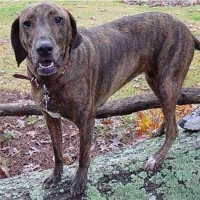Appearance of the Plott Hound
|
| The Plott Hound is definitely a hunting dog. It has an intelligent, alert expression and a confident demeanor. He will have brown or hazel eyes prominent on his head, with well-fitting eyelids. His nose should be black, but may be colored or brown. The Plott Hound's coat is dense enough to protect it from the elements when out hunting. The coat is fine and smooth to the touch. There are some remarkable Plott Hounds with a dense double coat and a harder texture. The double-coated Plott Hound should not be shown in conformation. The most prominent color for the Plott Hound is a brindle, which means it has a striped pattern of darker hairs on a lighter background. The most common brindle color is black, blue, red, tan or brown. The only other acceptable color is black. |
Temperament of the Plott Hound
|
| The Plott Hound is a devoted companion, willing to please as long as he thinks it will benefit him. Being a hunting dog, it has a stubborn tendency to make training a little difficult. He loves food and trains best when treats are used as rewards. Families living in apartments or even sub-divisions should not integrate a Plott Hound into their family. This is a very vocal dog with a high-pitched, very loud voice. Many people may not be thrilled to have a Plott Hound as a neighbor. Daily training of this somewhat energetic dog is essential to keep its owner sane. Plott Hounds generally get on well with other animals when trained to accept and respect them. Daily exercise is necessary to keep him happy and healthy. However, as he's prone to bloat, don't allow him to exercise immediately after eating a large meal. |
Needs and activities of the Plott Hound
|
| The Plott Hound is not recommended for apartment living. It can live and sleep outdoors, provided it has suitable shelter. This breed has no sense of direction and should be kept in a safe place, as it tends to wander. The Plott Hound needs plenty of physical exercise, which includes a daily long, brisk walk or jog. When walking, the dog should be heeled to the side or behind the person holding the leash, because in a dog's mind, the leader leads the way, and that leader must be the human. This well-muscled, rather lean dog has the stamina to work all day and late into the night. The Plott Hound should have chances to run free, but is a natural hunter and tends to run off and hunt if not kept in a well-fenced area while exercising off the trail. |
Maintenance of the Plott Hound
|
| The Plott Hound is not a hypoallergenic breed. Its short coat is easy to care for and should be brushed from time to time, usually once a week or so, to remove loose or dead hairs. In summer, the Plott Hound can be brushed monthly rather than weekly, unless you notice its coat losing its luster. Frequent brushing helps keep its coat and skin healthy, and removes dirt from its coat. He can be brushed with a smooth brush or a rubber curry brush. Since he's a dog with ears typical of hunting dogs, be sure to clean his ears weekly and check for bad odors, which can be a symptom of an ear infection. His nails should be trimmed every two or three weeks, depending on how fast they grow. Don't over-wash |







 English (United Kingdom)
English (United Kingdom)